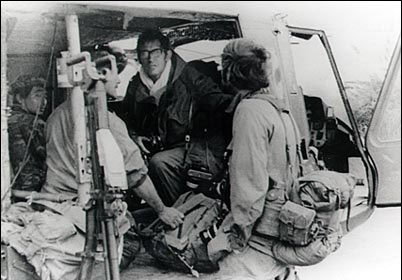Seeing
It Through to the End
"What’s the hardest thing of all? It’s to keep feeling. Yet if you feel too much – you’d break." - Larry Burrows
Ever leave a story unfinished? It’s just left hanging
there, in a strange limbo of not knowing how it’s ever going to end. For Larry
Burrows, he wasn’t willing to have this happen to his story. A British war
photographer for Life magazine, he felt it his job to document the stories of the
Vietnam War to the end. It was his hope to one day photograph a Vietnam at
peace. Getting a job as an
errand boy in the London bureau of Life at sixteen
he eventually was allowed to print some photographs, which happened to be of
war. They fascinated him. It became his goal to be a war photographer himself, and
with the Vietnam War, he got that chance. Exposed to all the same dangers and miserable
conditions soldiers are, being a war photographer wasn’t easy. Most
photographers on a newspaper deadline would stay only short periods of time. Larry
Burrows, however, working for a magazine, was given much more freedom to be
able to take his time. Staying in the field for longer periods of time meant he
could build more trusting relationships with the soldiers and to better
understand everything that was going on. Life was concerned for his safety,
though. Due to his poor eyesight, he would get right in the midst of the action
to get his pictures. Once, he apologized to the editors saying “sorry if my captioning is not up to
standard … but with all that sniper fire around, I didn’t dare wave a white
notebook.” (1) Because of their concern, Life would constantly send him off to
less action filled assignments, such as taking pictures of Mother Theresa, or
capturing images of rare birds (2). After completing such assignments, though,
Burrows would always return back to the battlefield. This fact could make one
question his emotional stability, if he took too much pleasure in the violence,
but as Greg Fallis writes of him “unlike some of the photographers who returned often
to Vietnam, Burrows wasn’t an adrenaline junkie. He was, instead, determined to
cover the war to the end, that was his assignment and he wouldn’t quit until
the assignment was finished.” (2)
 |
| Life |
In February, 1971, Larry boarded a military
helicopter, along with three other journalist photographers, heading over enemy
territory. The helicopter was shot down near the border of Laos. Because of the
location, no one dared to go look for the bodies, and Larry Burrows became MIA.
Many years later, upon investigation, all they found of him in the deteriorating
wreckage were pieces of his smashed up cameras. For Larry Burrows, the story
was ended. The
assignment left uncompleted. He never got the chance to
photograph a Vietnam at peace after all. Through his powerful photographs,
though, he opened people’s eyes to the horrors of war. He showed soldiers
together - brothers - who lived, suffered and died together. Larry Burrows
changed the world through his photographs, in ways that he probably wouldn’t
have even dared to hope.
 | ||
| Larry and the three other photographers as they board the helicopter | UTATA |
"Larry was English, a polite man, self-effacing, warm with his friends but totally cool in combat. He had deep passions, and the deepest was to make people confront the reality of the war, not look away from it. He was more concerned with people than with issues, and he had great sympathy for those who suffered …" -LIFE’s Managing Editor, Ralph Graves
Bibliography
(1.) "Vietnam War: The Story
Behind Larry Burrows’ Photo, ‘Reaching Out’ | LIFE | TIME.com." LIFE.
N.p., n.d.
Web. 11 Oct. 2014.
(2.) "Sunday Salon with Greg
Fallis." Sunday Salon » Larry Burrows. N.p., n.d. Web. 11 Oct.
2014.


Hi Daydreamer-
ReplyDeleteWe are inviting Sunday Social players to try Sunday Stealing during it’s hiatus. We’ve been around a log time and you might enjoy it…
The address is www.sundaystealing.blogspot.com
Bud